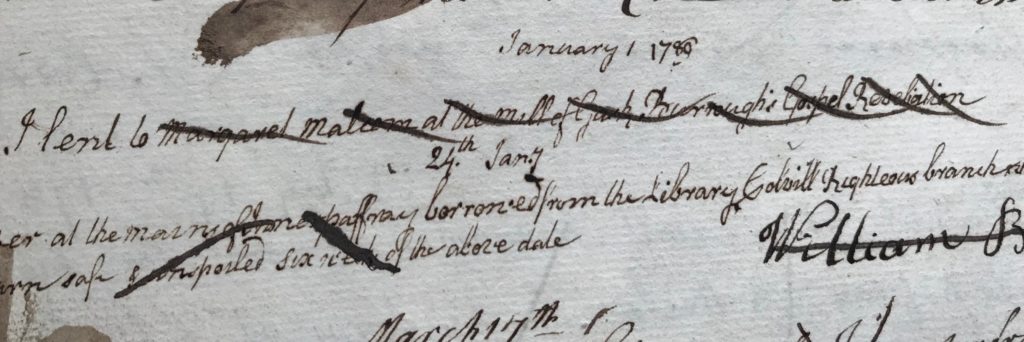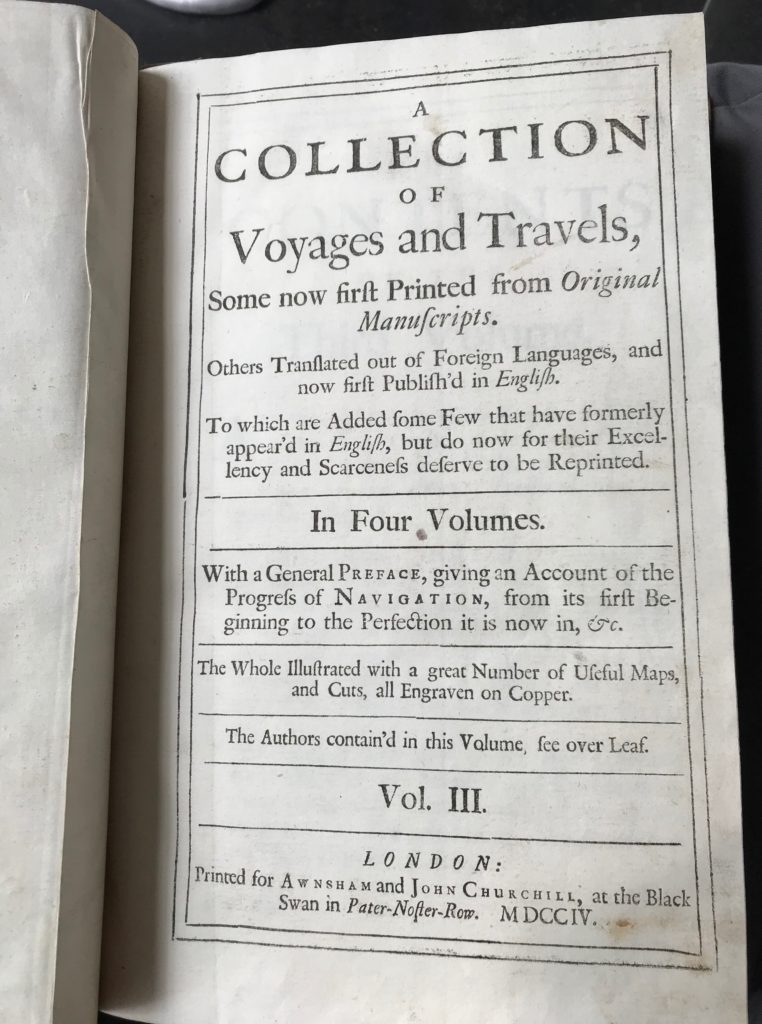This edition of Meet the Borrowers differs from the usual format in that it mentions all the women whose names appear in the Borrowers’ Register between the years 1747 and 1789. There may well have been women who borrowed books from the collection in the years between the founding of the library in 1680 and the earliest written records we hold, dating from 5th June 1747, but there are no documents to tell us.
The majority of these women are recorded as a Borrower on only one date, but it indicates to us that they were reading and gives us an insight into the subject matter. Despite using the vast amount of information and records that are available, and easily accessible, to a researcher today, we have been unable to discover very much at all about some of them. What we do know is that most of them were members of ordinary families, employed by the local land owners and living on the various estates in the area, including Innerpeffray. The only exceptions to this were the Hepburn ladies, of the Colquhalzie estate, and Louisa Drummond, a member of the wider Drummond family of Drummond Castle.
The first female recorded in the Borrowers’ Register is Beatrix Faichney, daughter of James Faichney and Margaret Richart. The family lived at Knappielands, a farm between Innerpeffray and Muthill, and a location that is still named on maps today. We know from baptism records of the Episcopal Church, Muthill, that at least eleven children were born to James and Margaret, including three sets of twins – William (1/9/1726), twins Elspeth and Jean (23/5/1727 – and this sad note recorded with the date ‘born before time. Jean died a few minutes after baptism’), twins Thomas and Joseph (17/5/1728), Beatrix (31/1/1731), Margaret (2/1/1734), twins Janet and Lilias (24/6/1738), James (2/5/1742) and Jean (2/5/1751).

The are only two entries for Beatrix, both entered at the bottom of the first page of the Borrowers’ Register, and the date was 29th August, 1747. From these entries we are led to conclude that Beatrix was probably employed as a servant on the Abercairney estate. Perhaps this was not the first time that she had borrowed books from Innerpeffray for ‘Mr Moray, at Abercairney’, and for herself.
The first entry reads as follows:
Lent to Mr Moray at Abercairney by Beatrix Faichney.
1st Volume of Clarendon Civil Wars, the History of Queen Elizabeth & the 1st Volume of the Compleat history of Europe.
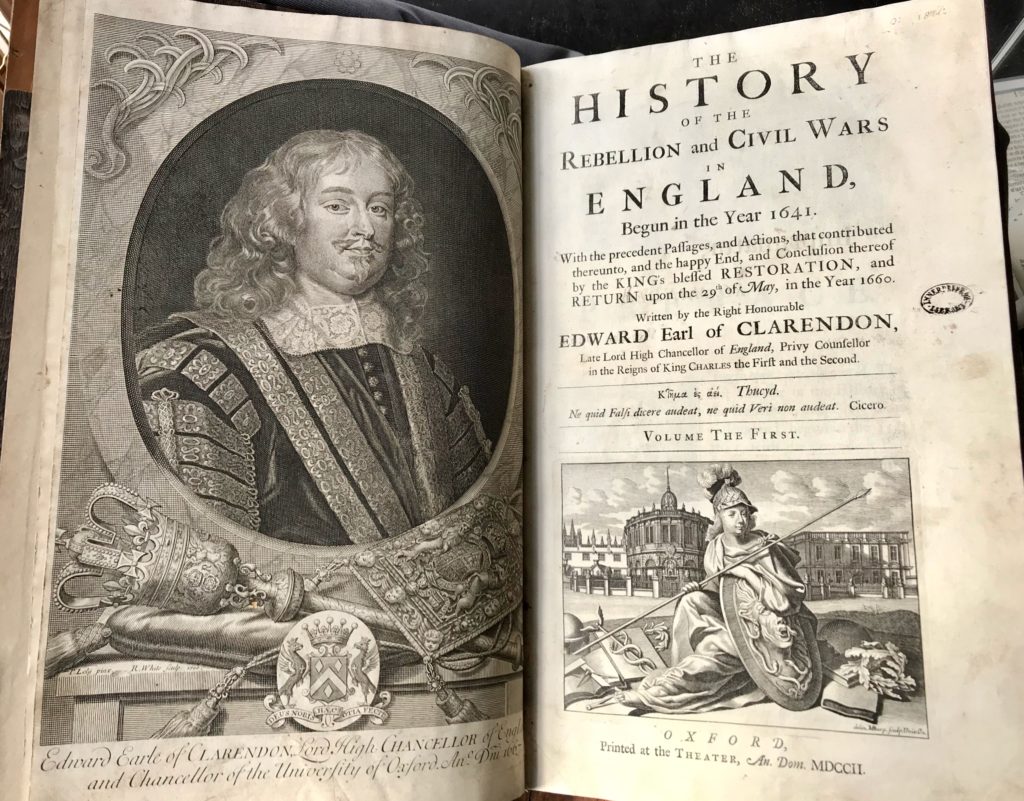
Second entry on the same date:
Lent Beatrix Faichney Christ the way the truth and the life.
On the 24th March, 1751, in the Parish of Crieff, Beatrix married William Roben. Unfortunately, after this date, the couple disappear from our story, as no further records of them living in the area, or further afield, have been discovered so far.
The second female Borrower named in the Register is Janet Cooper, living at Kirkhill of Innerpeffray. Her only entry is dated 12th September, 1747.
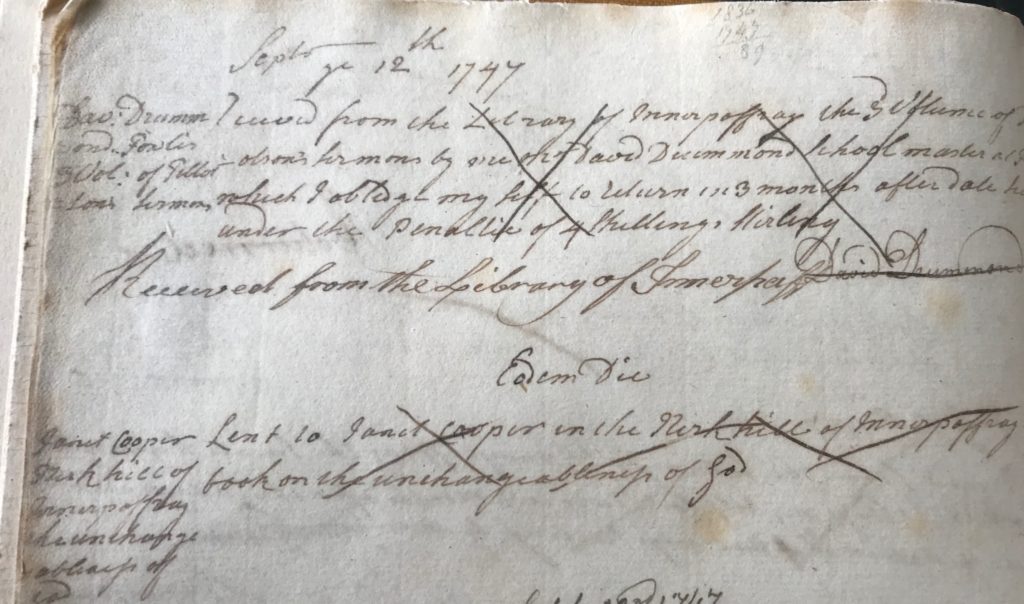
book on the unchangeableness of God.

Other than where Janet was living, we have been unable to discover anything else about her. The only possible reference is to a Janet Cowper, baptised at Fowlis Wester, in 1723.
Left: Mr. Pearse’s last Legacy – Two Discourses’ London 1687
The next female Borrower was ‘Elizabeth Faichney, in Loanhead’ on the 16th September, 1752. This Elizabeth was the daughter of Andrew Faichney and Elspeth Brugh, of Drumsachy/Drumsachany, baptised on the 13th November, 1730. There are baptisms recorded for three other children – John (13/11/1725), when the parents are listed as living at Innerpeffray, followed by Jean (15/5/1728) and James (22/1/1732) when they were living at Drumsachy/ Drumsachany. We have been unable to find any map, or descriptive reference, to enable us to identify this location. Drumness and Macheny, two adjacent settlements, may give us a clue as to where it might have been. Or it may even have been Drummawhance. When place names were being written, down the writer at the time would frequently spell them as they were pronounced. What appears on paper may bear little or no resemblance to the correct spelling!

Lent to Elizabeth Faichney in Loanhead Burroughs Saints Happiness
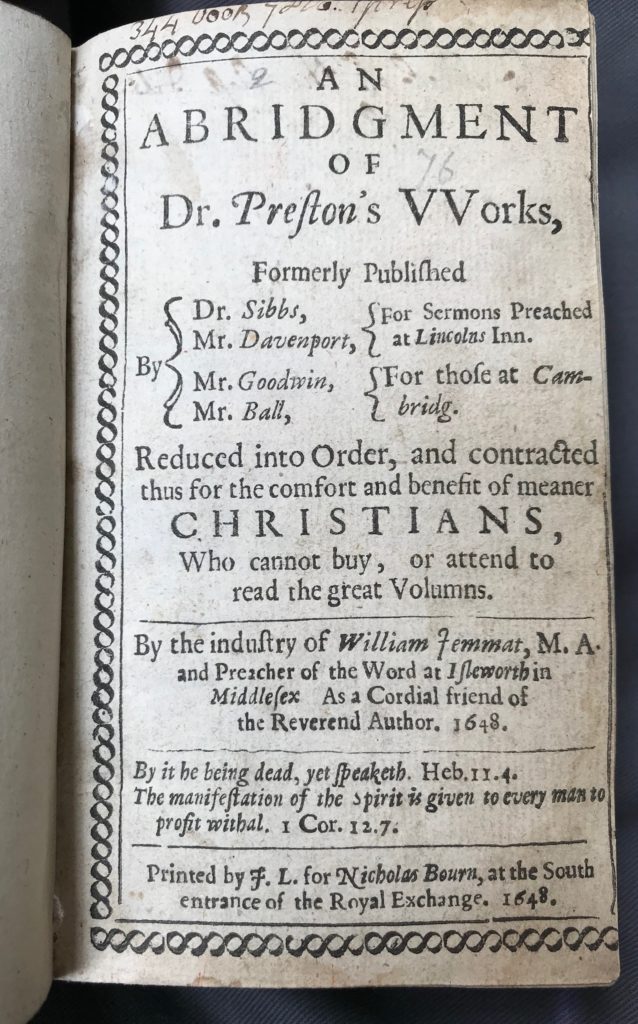
There were numerous branches of the Faichney family living in the area in the 17th and 18th centuries, several of whom borrowed books from the Library. However, from the Borrowers’ Register we can see that both John and James Faichney, in Loanhead, were also borrowing books in 1752 and 1753. John was a Master Stone Mason and he was in charge of the construction of the building in which the library has been housed since 1762.
The name ‘Margaret Morison, of Innerpeffray’, first appears on the 10th May, 1755, when she borrows ‘An Abridgement of Dr. Preston’s VVorks’ by William Jemmat, M.A., 1648 (see left)
There are two later entries for Margaret, one on 29th September, 1756, when she borrows William Perkins ‘Cases of Conscience’, and another on 13th November, 1756, when she borrows William Gouge’s ‘God’s three arrovves’. On the 24th July, 1756, a ‘Duncan Morison, Kirkhill of Innerpeffray, a servant to James Sharp’, borrowed a book. Perhaps he was Margaret’s husband.
The next female Borrower was ‘John Allan’s wife’ on the 29th September, 1756. John Allan had married Helen Dawson, in Muthill, and births and baptisms were recorded for their children, the first being Ann, born on 12th February 1745. She was followed by Mary (24/2/1748), James (7/7/1750), John (9/3/1751), John (20/3/1753) – it was common practice to give the same name to another child after the death of the first one of that name and this occurs again with James (27/7/1755). Then there was Helen (16/11/1757), Margaret (24/7/1760), David (26/4/1764) and Christian (26/4/1767).
John Allan is recorded in the Borrowers’ Register as ‘Gardner at Innerpeffray’, and he borrowed books from 12th May, 1753, until 1756 and then again between 1764 and 1766. However, there is only the one entry for his wife, who would no doubt have been fully occupied looking after their young family and would have had little time to sit and read. Interestingly, the one book that she did borrow was ‘An Abridgement of Dr. Preston’s VVorks’ edited by William Jemmat, M.A., 1648, the same book that her near neighbour, Margaret Morison, had borrowed the previous year. Perhaps Margaret had discussed the book with Helen Allan and encouraged her to come to the library and borrow it for herself.
There was no borrowing at all recorded between the 17th February, 1759 and 16th November, 1763. This was the time when the building that now houses the Library of Innerpeffray was under construction.
There is then a lack of female borrowers until ‘Mrs. Mary Drummond, Innerpeffray’, on the 18th December, 1765. She borrows ‘The History of the Rebellion and Civil Wars in England, Begun in the Year 1641’ by Edward Earl of Clarendon. Oxford 1702 and ‘A Collection of Voyages and Travels Vols. 3 & 4’ . London 1704

On the 9th May, 1771, ‘Louisa Drummond at the Castle of Drummond’, borrowed ‘La Sainte Bible de Port Royal. Louisa was a daughter of Andrew Drummond, who served as a colonel in the French army, and his wife, Magdalena Silvia, who was the daughter of a Lieutenant General in the French army.
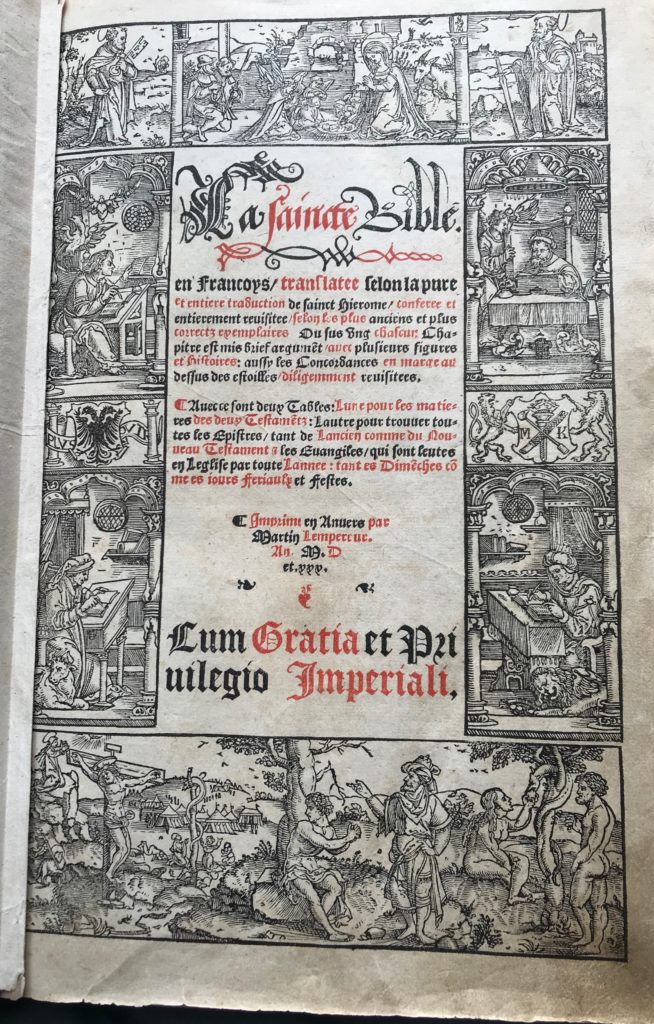
She borrowed the same book again on the 31st August, 1773, along with ‘Goguet origins
des loix, des arts, et des sciences. 1758’
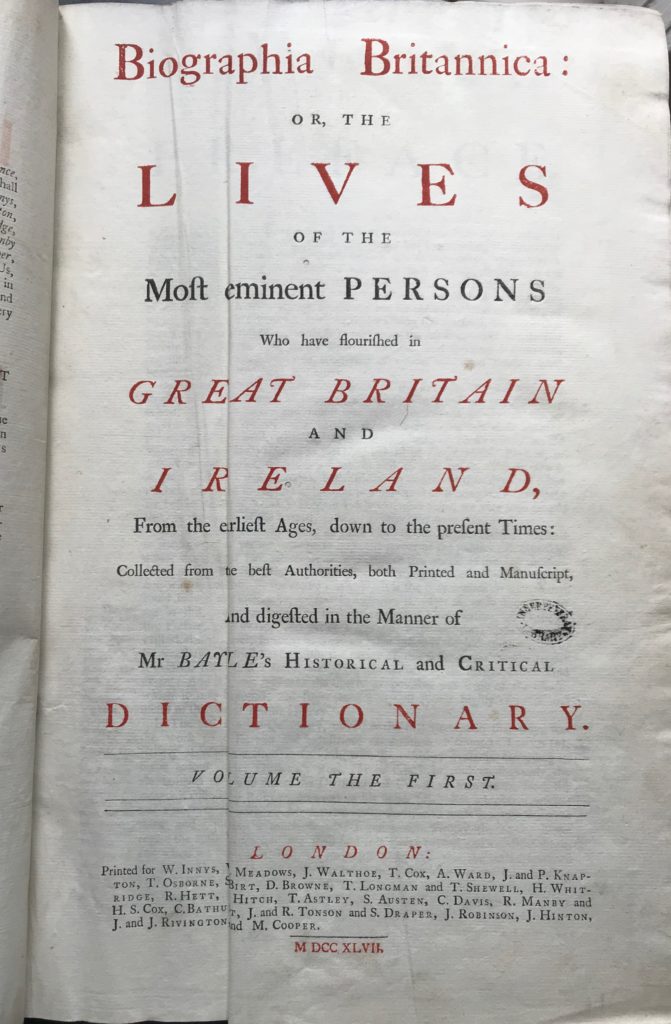
Mrs Hepburn, wife of John Hepburn Esq. of Colquhalzie, became a borrower, on the 6th December, 1775. John Hepburn had succeeded to the Colquhalzie Estate on the death of his mother’s cousin, Dorothea Stewart. He married Margaret Bissett, daughter of James Bissett of Ferdal, and they had two children, a daughter, Helen, and a son, Thomas.
The first book Mrs. Hepburn borrowed was ‘A Harmony of four Gospels’ by James Macknight. Her husband was already a borrower before her and their son, Thomas, had first borrowed a book from Innerpeffray in 1771. He borrows again in 1772, 1776 and then with much more frequency between 1790 and 1813.
The next time we see the name of ‘Mrs. Hepburn, of Colquhalzie’, is in January 1782, when she borrows ‘(Jeremiah) Burroughs Saints Happiness’ and ‘An exposition of the Creed’ by John Pearson. However, this entry could be either Mrs. (Margaret) Hepburn borrowing once more or it could be Mrs. (Mary) Hepburn, Thomas’s wife, whom he married in 1781. An entry for a Mrs. Hepburn, Colquhalzie, does not appear again until 23rd August, 1805, when she borrows ‘Biographia Britannica’ and Jeremiah Seed’s ‘Sermons’.
On 1st January, 1789, Margaret Malcom, at Mill of Gask, borrows Burrough’s ‘Gospel Revelation’. There is only this one entry for her and other than where she was living at the time, we have no other information about her. She could be the Margaret Malcom baptised in Auchterarder on the 18th January, 1767, and daughter of William Malcom and Betty Clement. She may be the Margaret Malcom whose name is recorded on the 1841 Census, as living at East Kirkton, Auchterarder. These are the kind of dilemmas faced when trying to identify many Borrowers, both male and female. especially when there are numerous families living in the same areas with the same forenames, surnames and of similar ages.
